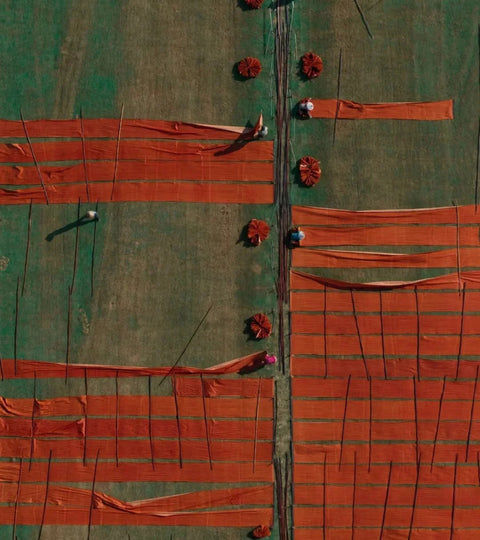In a world increasingly defined by speed and automation, Xiangyun silk (香云纱), also known as Gambiered Guangdong Silk, offers a quiet counterpoint: a return to slowness, nature, and deep-rooted tradition. With a history that spans over 500 years, this rare and beautiful fabric continues to be made by hand in southern China, using nothing more than silk, plants, river mud, sunshine—and generations of skill.
This is the story behind the luminous cloth we use in our beloved tea mats, garments, and textile pieces. It is a material I personally love and admire—not just for its texture and appearance, but for the care and wisdom it embodies.
A Silk Rooted in Nature and Medicine
The journey of Xiangyun silk begins with 100% mulberry silk, known for its strength and softness. But its beauty is not in the silk alone—it comes alive in the dyeing process, which uses a remarkable plant called gambier (薯莨 / shǔ liáng). In traditional Chinese medicine, gambier is known for its astringent and detoxifying properties. In textile art, it acts as a natural tannin-rich dye that gives Xiangyun silk its distinctive warm undertones—ranging from bronze gold to deep wine red.
The silk is soaked in a concentrated gambier extract, then laid under the open sun to oxidize and deepen in color. This sunlight-dyeing cycle is repeated many times, layer upon layer, until the color becomes rich, deep, and stable. At this stage, the cloth is still soft in tone—but something magical is about to happen.

Iron, Earth, and Sunlight: The Signature Mud Dyeing
The most iconic step of Xiangyun silk-making is the river mud coating—a practice found nowhere else in the world.
Once the silk has absorbed enough of the plant dye, artisans apply a layer of iron-rich river mud across the surface of the fabric. This isn’t ordinary dirt: the mud is carefully selected from specific areas near the Pearl River Delta, where the mineral content is just right to interact with the gambier dye.
Then, the silk is returned to the sunlight again, where the tannins in the dye react with the iron compounds in the mud, creating a natural chemical transformation. The result is a surface that becomes darker, glossier, and slightly fragrant—developing the classic black-brown sheen that Xiangyun silk is known for.
This mud-coating and sun-drying process is repeated up to ten times. Each cycle deepens the color, seals in the finish, and enhances the silk’s texture and durability.
Beauty That Grows With Time
Xiangyun silk is not meant to be perfect—it’s meant to be alive.
Because it is handmade and sun-dried in open air, every piece carries slight variations in tone, shine, and texture. These are not flaws, but signs of authenticity and craftsmanship. Some pieces may appear warmer or darker depending on the season, weather, or even the skill of the artisan that day.
Another reason I love this fabric is that it evolves. With regular use—whether as a garment or a tea mat—Xiangyun silk becomes softer and more lustrous. It develops what we call a “patina of use,” similar to polished wood or burnished leather. The more it lives with you, the more beautiful it becomes.

From Clothing to Tea Life
While Xiangyun silk is traditionally used to make elegant summer clothing—qipao dresses, jackets, scarves—its durability and visual beauty also make it ideal for tea settings.
We to use authentic Xiangyun silk to create tea mats (茶席布) that feel as grounded and thoughtful as the tea ceremony itself. The silky finish provides a beautiful contrast to ceramics, and the fabric’s cool, breathable nature is perfectly suited to the quiet elegance of gongfu tea.
I also love how the slight sheen of the surface picks up the colors of teaware and ambient light—it’s subtle, but it transforms every tea session into something more intimate and special.
A Living Heritage, Still Handmade Today
Xiangyun silk is more than a fabric—it is a living piece of Chinese heritage. And in a time when fast fashion dominates and machine-made cloth floods the market, it’s heartening to know that small communities of artisans are still making Xiangyun silk the slow, old-fashioned way.
When you run your hands across this cloth, you’re touching sunlight, riverbed, tradition, and time—all held together by human hands.
I hope this post helps you appreciate why I love this fabric so much—and why I’m so happy to share it through our tea products. 💛



